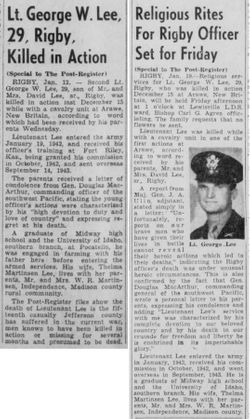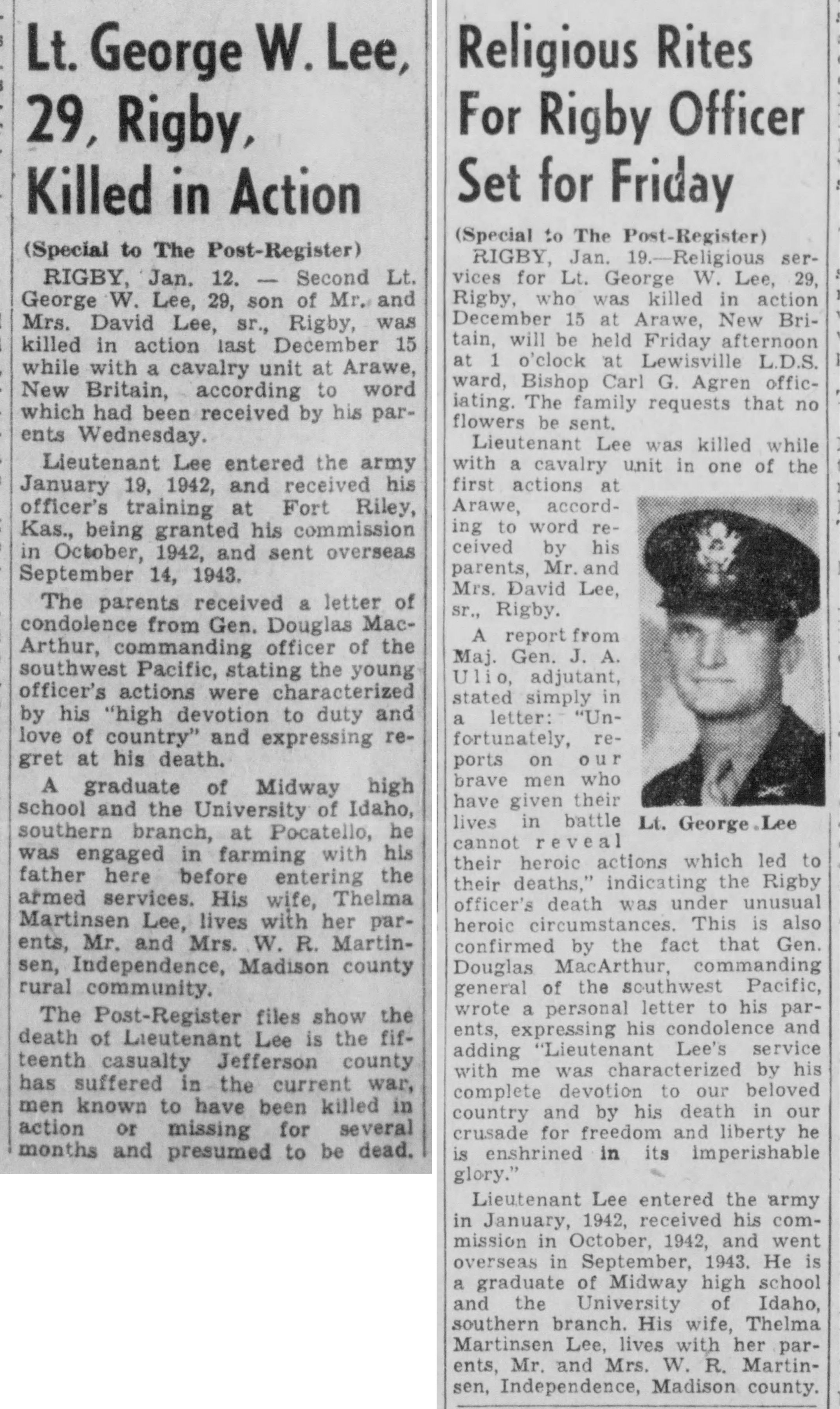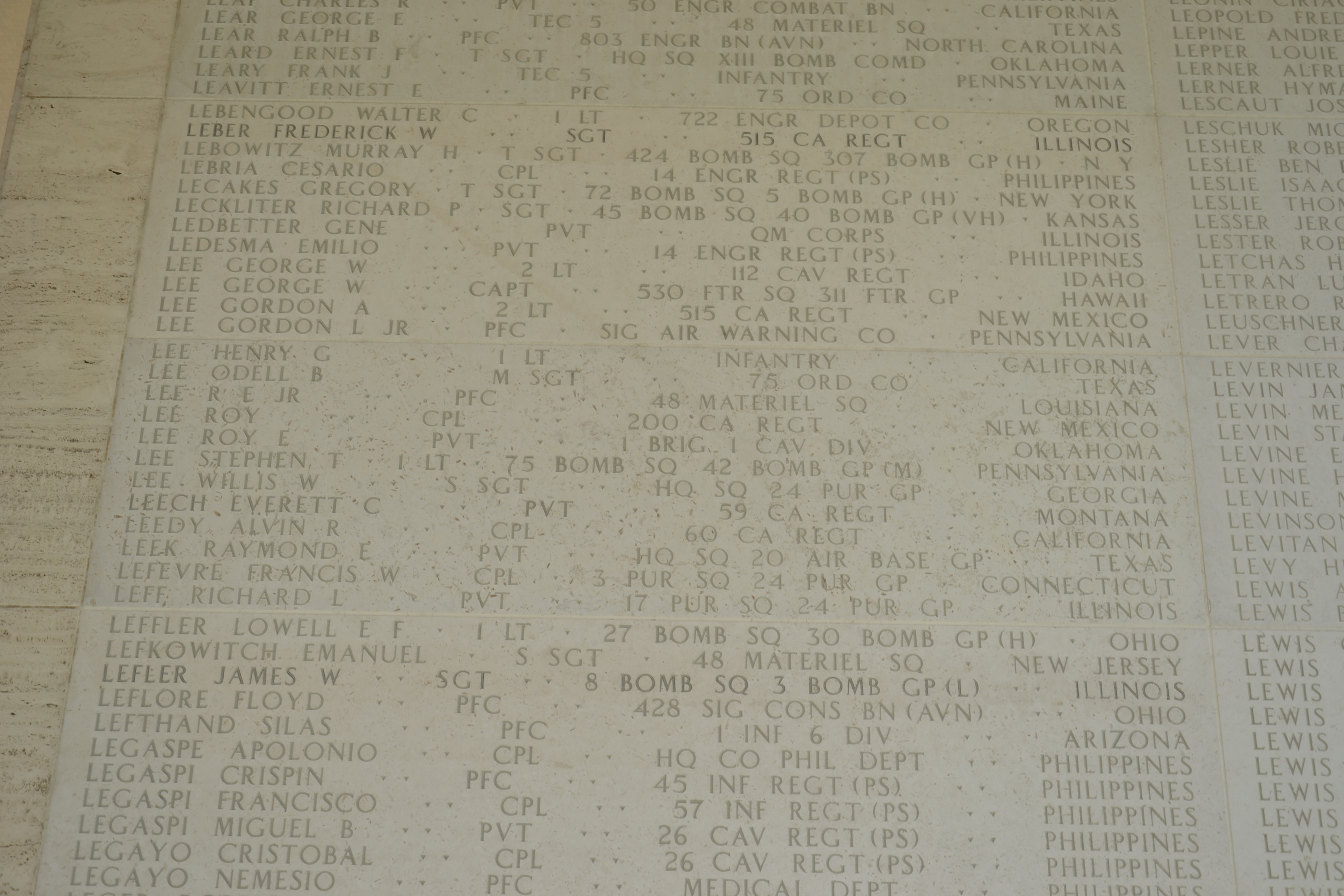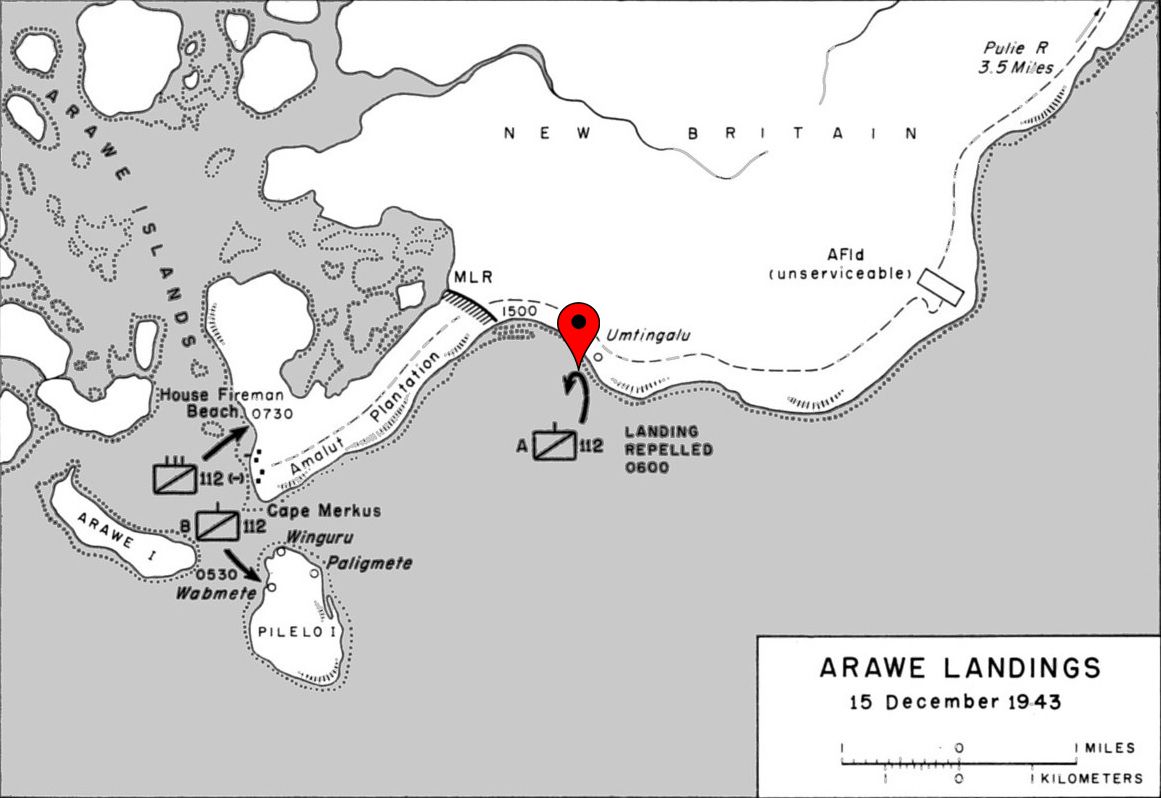Entered Service From: Idaho
Service #: 1030899
Unit: Troop A, 112th Cavalry Regiment, U.S. Army
Date of Death: December 15, 1943, near Umtingalu, Arawe Peninsula, New Britain, Territory of New Guinea
Status: Missing In Action
Memorialized: Manila American Cemetery – Walls of the Missing
Awards: Bronze Star, Purple Heart
December 1943, the 112th Cavalry Regiment, attached to the 32nd Infantry Division, was involved in diversionary attacks up and down the northern coast of New Britain. The goal of the regiment was to disrupt the Japanese defense in the area, spread them out and confuse the enemy into guessing where and when the U.S. was actually going to invade. The plan was simple enough, land a company or two on a secure beach, push inland until contact is made, then withdraw quickly.
The 1st Battalion, 112th Regiment made two landings upon the Arawe Peninsula of New Britain’s southwest coast on December 14. Both of these landings were unopposed and the missions completed successfully. On December 15 one more landing was to occur. This time it would be near the boat harbor of Arawe. This time it was no diversion. The American units were there to stay. The navy and air force pounded the jungle-covered, volcano-studded island with 356 tons of explosives to soften up the landing area. The 2nd Battalion, along with elements of the 158th Infantry Battalion, the 2nd Marine Amphibious Tank Company, and the 148th Field Artillery Battalion assaulted the Arawe beach at 5:00a.m. The units were designated as Task Force Director under command of Brigadier General Julian W. Cunningham.
Five miles west of the landing site, a diversionary assault by 150 Commando-trained troops, slipped into rubber boats from transports. The commandoes were designated as Troops A, B, and C. They paddled ashore, under cover of darkness, entering a wooded narrow channel. Their goal was to get behind the Japanese defending the principle landing site, and disrupt reinforcements. A Japanese spotter plane discovered the advancing diversion. Thinking this to be the main attack, the Japanese quickly prepared to meet the landing. At close range they opened fire with machine guns and heavy mortars. The U.S. loss was extreme. The enemy fire destroyed eleven of the sixteen rubber boats, killed or wounded most of the 150 commandoes, and forced the rest to turn back. Their sacrifice enabled the rest of the landing forces to get ashore and by January 16, 1944, all Japanese resistance on Arawe had ended.
One of those men lost in this diversionary assault was George Lee.
George was born on December 4, 1914 in the small farming community of Bybee, Idaho. Bybee is just north of the town of Rigby. He was the second youngest child of Mary Ellen and David Lee. Mary and David had five boys and two girls. The entire family grew up working on the farm and it was always a dream of George to own his own farm.
In 1940, with his four brothers away to school or working on their careers, George’s dream was fulfilled. He was able to purchase, with the help of his father, forty-acres of land just north of the family farm. Being the last boy at home, and with his father suffering a minor heart attack in 1938, he was kept very busy with a heavy workload.
George was not expecting to get drafted. Owning a farm and still helping on his father’s farm as the last son gave him two deferments from the draft. Early in the war the manpower need in the military was extreme. Every able-bodied young man was needed. With the draft looming close, George volunteered in early 1942, which gave him his choice of service. George’s choice was a natural, the cavalry because of his love for horses that he learned at a young age on the family farm.
On July 8, 1942, George married Thelma May (Dot) Martinsen. Thelma was an elegant young woman who worked at a dress shop in Rigby. They were only married a short time before the war called.
Following his basic training, George took an aptitude test that qualified him to be trained as an officer. His opportunity to be in the horse cavalry was not realized as the army had considered this branch obsolete. George graduated officer school in the fall of 1943 and was assigned to the 112th Cavalry Regiment as a Second Lieutenant. The 112th was being deployed to the Pacific to engage the Japanese in the Solomon Islands, New Guinea, New Britain, and Rabaul. These battles were the first offensive actions taken by the U.S. to push the Japanese back towards their home islands.
George was killed on December 15, 1943, during the doomed diversionary landings at Arawe. He was not supposed to be involved in the assault as he had orders to proceed farther up the coast to the main landings. He was asked by a friend and fellow officer to accompany the assault to replace a Lieutenant that was not present. This was only going to be a diversion, nothing too serious.
The loss to the family was extreme. The sorrow was greatest on his father, David. George was the last boy at home and the relationship between father and son was very close.
George’s body was never recovered after the battle at Arawe.
Source: http://www.arlingtoncemetery.net/gwlee.htm
*****************************************************************************************
Dawn was still one hour away when 150 men of A Troop, 112th Cavalry Regiment, who had been aboard the USS Sands (APD 13), started for the beach at Umtingalu in fifteen rubber boats. They had been ordered to make a surprise landing in darkness at H minus 1 hour and block the coastal trail that was the Japanese escape and reinforcement route to the east. About 0525, when the boats were approximately 100 yards offshore, troops "received heavy machine gun fire, considerable rife fire and fire from a large caliber automatic weapon. This was later found to be a 25mm anti-aircraft, dual-purpose gun. The landing was repulsed by this heavy fire from concealed prepared positions and all but three of the landing craft were sunk."
"Pfc. Kenneth J. Cook and Pfc. James C. Johnson report that Lt. Lee was hit by a Japanese 25 MM anti-aircraft shell. Wounds were sustained in the chest and leg. Lt. Lee remarked that he had lost a leg although it was too dark to see distinctly. To the best of our knowledge Lt. Lee drowned when the boat in which he was riding in was sunk. The body was not recovered for burial."
He has cenotaphs in Central Cemetery, Grant, Jefferson County, Idaho and in Arlington National Cemetery, Arlington, Virginia – Section MK, Site 62
Entered Service From: Idaho
Service #: 1030899
Unit: Troop A, 112th Cavalry Regiment, U.S. Army
Date of Death: December 15, 1943, near Umtingalu, Arawe Peninsula, New Britain, Territory of New Guinea
Status: Missing In Action
Memorialized: Manila American Cemetery – Walls of the Missing
Awards: Bronze Star, Purple Heart
December 1943, the 112th Cavalry Regiment, attached to the 32nd Infantry Division, was involved in diversionary attacks up and down the northern coast of New Britain. The goal of the regiment was to disrupt the Japanese defense in the area, spread them out and confuse the enemy into guessing where and when the U.S. was actually going to invade. The plan was simple enough, land a company or two on a secure beach, push inland until contact is made, then withdraw quickly.
The 1st Battalion, 112th Regiment made two landings upon the Arawe Peninsula of New Britain’s southwest coast on December 14. Both of these landings were unopposed and the missions completed successfully. On December 15 one more landing was to occur. This time it would be near the boat harbor of Arawe. This time it was no diversion. The American units were there to stay. The navy and air force pounded the jungle-covered, volcano-studded island with 356 tons of explosives to soften up the landing area. The 2nd Battalion, along with elements of the 158th Infantry Battalion, the 2nd Marine Amphibious Tank Company, and the 148th Field Artillery Battalion assaulted the Arawe beach at 5:00a.m. The units were designated as Task Force Director under command of Brigadier General Julian W. Cunningham.
Five miles west of the landing site, a diversionary assault by 150 Commando-trained troops, slipped into rubber boats from transports. The commandoes were designated as Troops A, B, and C. They paddled ashore, under cover of darkness, entering a wooded narrow channel. Their goal was to get behind the Japanese defending the principle landing site, and disrupt reinforcements. A Japanese spotter plane discovered the advancing diversion. Thinking this to be the main attack, the Japanese quickly prepared to meet the landing. At close range they opened fire with machine guns and heavy mortars. The U.S. loss was extreme. The enemy fire destroyed eleven of the sixteen rubber boats, killed or wounded most of the 150 commandoes, and forced the rest to turn back. Their sacrifice enabled the rest of the landing forces to get ashore and by January 16, 1944, all Japanese resistance on Arawe had ended.
One of those men lost in this diversionary assault was George Lee.
George was born on December 4, 1914 in the small farming community of Bybee, Idaho. Bybee is just north of the town of Rigby. He was the second youngest child of Mary Ellen and David Lee. Mary and David had five boys and two girls. The entire family grew up working on the farm and it was always a dream of George to own his own farm.
In 1940, with his four brothers away to school or working on their careers, George’s dream was fulfilled. He was able to purchase, with the help of his father, forty-acres of land just north of the family farm. Being the last boy at home, and with his father suffering a minor heart attack in 1938, he was kept very busy with a heavy workload.
George was not expecting to get drafted. Owning a farm and still helping on his father’s farm as the last son gave him two deferments from the draft. Early in the war the manpower need in the military was extreme. Every able-bodied young man was needed. With the draft looming close, George volunteered in early 1942, which gave him his choice of service. George’s choice was a natural, the cavalry because of his love for horses that he learned at a young age on the family farm.
On July 8, 1942, George married Thelma May (Dot) Martinsen. Thelma was an elegant young woman who worked at a dress shop in Rigby. They were only married a short time before the war called.
Following his basic training, George took an aptitude test that qualified him to be trained as an officer. His opportunity to be in the horse cavalry was not realized as the army had considered this branch obsolete. George graduated officer school in the fall of 1943 and was assigned to the 112th Cavalry Regiment as a Second Lieutenant. The 112th was being deployed to the Pacific to engage the Japanese in the Solomon Islands, New Guinea, New Britain, and Rabaul. These battles were the first offensive actions taken by the U.S. to push the Japanese back towards their home islands.
George was killed on December 15, 1943, during the doomed diversionary landings at Arawe. He was not supposed to be involved in the assault as he had orders to proceed farther up the coast to the main landings. He was asked by a friend and fellow officer to accompany the assault to replace a Lieutenant that was not present. This was only going to be a diversion, nothing too serious.
The loss to the family was extreme. The sorrow was greatest on his father, David. George was the last boy at home and the relationship between father and son was very close.
George’s body was never recovered after the battle at Arawe.
Source: http://www.arlingtoncemetery.net/gwlee.htm
*****************************************************************************************
Dawn was still one hour away when 150 men of A Troop, 112th Cavalry Regiment, who had been aboard the USS Sands (APD 13), started for the beach at Umtingalu in fifteen rubber boats. They had been ordered to make a surprise landing in darkness at H minus 1 hour and block the coastal trail that was the Japanese escape and reinforcement route to the east. About 0525, when the boats were approximately 100 yards offshore, troops "received heavy machine gun fire, considerable rife fire and fire from a large caliber automatic weapon. This was later found to be a 25mm anti-aircraft, dual-purpose gun. The landing was repulsed by this heavy fire from concealed prepared positions and all but three of the landing craft were sunk."
"Pfc. Kenneth J. Cook and Pfc. James C. Johnson report that Lt. Lee was hit by a Japanese 25 MM anti-aircraft shell. Wounds were sustained in the chest and leg. Lt. Lee remarked that he had lost a leg although it was too dark to see distinctly. To the best of our knowledge Lt. Lee drowned when the boat in which he was riding in was sunk. The body was not recovered for burial."
He has cenotaphs in Central Cemetery, Grant, Jefferson County, Idaho and in Arlington National Cemetery, Arlington, Virginia – Section MK, Site 62
Inscription
2LT, 112 CAV WORLD WAR II
Gravesite Details
He also has memorial markers at the Arlington National Cemetery and the Central Cemetery in Grant, Idaho.
Family Members
Sponsored by Ancestry
Advertisement
Explore more
Sponsored by Ancestry
Advertisement













